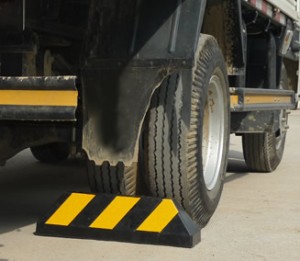 Print a Sign-In Sheet | Spanish Version
Print a Sign-In Sheet | Spanish Version
Chocking and blocking prevent accidental or unintended movement of trucks and cargo while loading and unloading and while performing service or maintenance. Chocking the wheels of a truck, trailer, or tractor prevents the wheels from rolling, eliminating runaway equipment that can injure workers. Blocking stabilizes cargo loads to prevent shifting and trailer overturns.
- When chocking, use truck wheel chocks designed for that purpose.
- Do not use blocks, pieces of lumber, or other makeshift items to chock.
- Keep chocks stored inside trailers and truck rigs so that employees may readily locate them. Keep chocks available at loading docks and ensure they are chained to the dock to prevent them from being misplaced.
- When exiting a vehicle after stopping, ensure the vehicle is at a complete stop, set the brake, and ensure the vehicle will not roll forward or backward before you exit.
- If you are performing maintenance or parking the vehicle for an extended period of time, chock the wheels.
- To properly chock a freestanding vehicle, place chocks on the left and right rear axle wheels. It is safest to chock both the front and back of each tire.
- Ensure that trailers are firmly placed against loading dock edges.
- Place chocks on the left and right wheels that are closest to the loading dock. This placement allows a forklift to push down on the trailer wheels and seat them more firmly against the chock. If only the front axle is chocked, a forklift could push the trailer forward and loosen the chock or cause the wheel to jump the chock. The truck driver, dock workers, and forklift drivers share responsibility to ensure that the truck and trailer wheels are properly chocked.
- Block or secure trailer cargo to prevent the load from shifting during transit and unloading. Shifting loads can strike, injure, and engulf workers, while a sudden shift in the center of gravity can overturn a trailer.
- Securely block all cargo, not just wheeled equipment and round items.
- Block items separately and on all four sides using lumber thick enough to prevent cargo movement.
- Use nails or spikes long enough to secure the lumber and drive them in at opposing angles.
- Do not use other freight or cargo as a block.
KEMI does not assume liability for the content of information contained herein. Safety and health remain your responsibility. This information is to be used for informational purposes only and not intended to be exhaustive or a substitute for proper training, supervision, or manufacturers’ instructions/recommendations. KEMI, by publication of this information, does not assume liability for damage or injury arising from reliance upon it. Compliance with this information is not a guarantee or warranty that you will be in conformity with any laws or regulations, nor does it ensure the absolute safety of any person, place, or object, including, but not limited to, you, your occupation, employees, customers, or place of business.

